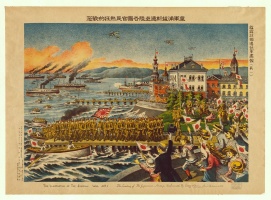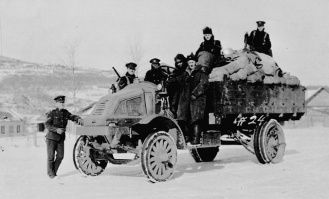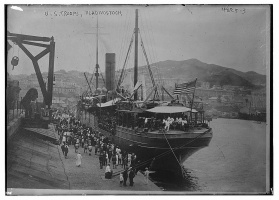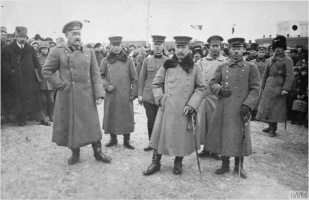Origins↑
Following the November 1917 Bolshevik Revolution in Russia, the Allies contemplated sending a combined Japanese and American force to Vladivostok. Although similar in character to the British and American intervention in Murmansk, the scope of contemplated objectives was broader, ranging from the need to protect Allied war stocks from falling into enemy hands to the reconstitution of an Eastern Front against the Germans. Lack of agreement on the scope, scale, and the ultimate objective of their operations delayed landing until the summer of 1918 when the revolt of the “Czech Legion” opened large portions of the Trans-Siberian Railway and assisted in the overthrow of Bolshevik regimes throughout Siberia and the Russian Far East. In July 1918 President Woodrow Wilson (1856–1924) proposed that a joint expedition of 7,000 troops each from the U.S. and Japan land in Vladivostok.
Allied Intervention 1918–1920↑
While the vast majority of troops joining Czechoslovak and White Russian forces came from Japan and the United States, British, French, Canadian, Belgian, Polish, Serb, Italian, Romanian and Chinese contingents also contributed to the “Siberian Intervention”, which began in August 1918. Ostensibly dispatched to rescue Czech troops, the objectives (both stated and unstated) of the intervening powers were diverse and conflicting. U.S. objectives included securing the vast stores of Allied war materials still awaiting shipment along the Trans-Siberian Railway in Vladivostok from potential seizure by “Austro-German” prisoners of war in the region who were largely unsupervised due to the revolutionary disorder. The U.S. also dispatched government and non-government experts to stabilize the region’s economy and civil society. Japanese expansionists, especially on the Imperial Army General Staff, sought to wrest control of the region from Russia. They dispatched 72,000 troops to secure the Trans-Siberian Railway as far west as Irkutsk and the Chinese Eastern Railway (a Russian-controlled line) running through Northern Manchuria.
The initial rationale for the intervention was quickly undermined. In September 1918 the Rice Riots produced Japan’s first political party cabinet under Hara Takashi (1856–1921). He repudiated the more aggressive designs of the general staff. The armistice on 11 November 1918 removed the need to resist German power as a justification for intervention. A week later Admiral Alexander Kolchak (1874–1920) seized control of the White Government based at Omsk in a coup. He requested Allied recognition and assistance in his invasion of European Russia (with Czech forces acting as the spearhead) to overthrow the Bolsheviks. The nominally anti-German intervention, while supposedly neutral in the Russian Civil War, leaned distinctly against the Bolsheviks.
Mutually conflicting objectives crippled the “Allied” intervention in Siberia over the course of 1919. Japanese expansionists supported the Cossack leaders Gregori Semenov (1890–1946) in the Trans-Baikal and Ivan Kalmykov (1890–1920) in Khabarovsk in their efforts to undermine the Omsk regime and assisted them in brutal repression of “partisans” throughout those areas. This ultimately sparked rising anti-Japanese resistance and contributed to a growing wave of criticism of the intervention in the Japanese mass media. American forces doggedly stuck to their orders not to interfere in Russian internal affairs while trying to provide stable operations of the Trans-Siberian Railway and relief for refugees. The Hara cabinet attempted to rein in the worst excesses of Japanese troops in response to American protests but the Imperial Army General Staff, evoking the “Right of Supreme Command” (established in the 1880s to prevent civilian interference in military operations), rebuffed its efforts.
Unilateral Intervention 1920–1922↑
The White offensive against the Bolsheviks failed in late 1919 and Bolshevik counter-offensives destroyed the Omsk regime. By February 1920 Kolchak was dead, the Red Army had seized Irkutsk, and the Americans announced their intent to withdraw (the final contingent taking ship from Vladivostok on 1 April 1920). The Japanese did not withdraw. Partly due to the massacre of 700 Japanese soldiers and civilians at Nikolaevsk on the Amur River in the spring of 1920, but also out of a desire to extract concessions from the Russian government, the Hara Cabinet announced on 31 March 1920 that Japanese forces would remain in the Russian Far East until order had been restored.
While pulling back from the Trans-Baikal region and much of Northern Manchuria, the Japanese reorganized a rump intervention centered on Vladivostok and the Maritime Province. At the same time, the Bolsheviks – under orders from Vladimir Lenin (1870–1924) – organized the unoccupied territories into the Far Eastern Republic (F.E.R.), a nominally non-communist buffer state designed to secure the withdrawal of Japanese troops. Meanwhile a coup in Vladivostok created a new White regime with limited Japanese support. In the spring of 1921 Hara Takashi’s “Eastern Conference” of Japanese diplomatic and military leaders determined the price of Japanese withdrawal from the Maritime Province but negotiations with F.E.R. delegates in Dairen produced no agreement.
Following Hara’s assassination in November 1921, new political leadership in Japan in the summer of 1922 announced the intent to withdraw Japanese forces by October 1922. Renewed negotiations with the F.E.R. again failed to produce anything and F.E.R. troops seized territories as soon as Japanese forces evacuated them. Within hours of the final pullout of Japanese troops from Vladivostok on 25 October 1922, F.E.R. forces entered the city. Two weeks later the F.E.R. was absorbed by the Soviet Union, Bolshevik control throughout Siberia was established, and the Russian Civil War was ended.
In Japan the intervention left a mixed legacy. There was widespread public anger at the army for the vast expense of the fruitless intervention and chagrin that the army’s actions gave weight to the notion that Japan had not transcended the spirit of “militarism” supposedly undone by the war. Yet there was equal disdain for the inability of party government in Japan to deliver on public desires to bring the profitless intervention to an end. For the military and party politicians both, the task ahead was to attempt to regain the public’s trust. The military succeeded and the parties failed, with ultimately fateful results.
Paul Dunscomb, University of Alaska Anchorage
Section Editors: Jan Schmidt; Sōchi Naraoka
Selected Bibliography
- Dunscomb, Paul: Japan's Siberian intervention, 1918-1922. A great disobedience against the people, Lanham 2011: Lexington Books.
- Hosoya, Chihiro: Shiberia shuppei no shiteki kenkyū (A historical study of the Siberian Intervention), Tokyo 2005: Iwanami Shoten.
- Izao, Tomio: Shoki Shiberia Shuppei no Kenkyū (Research on the early Siberian Intervention), Fukuoka 2003: Kyūshū daigaku shuppankai.
- Morley, James William: The Japanese thrust into Siberia, 1918, New York 1954: Columbia University Press.
- Norton, Henry Kittredge: The far eastern republic of Siberia, London 1923: Allen & Unwin.
- Sablin, Ivan: The rise and fall of Russia's Far Eastern Republic, 1905-1922. Nationalisms, imperialisms, and regionalisms in and after the Russian Empire, London 2020: Routledge.
- Smith, Canfield F.: Vladivostok under Red and White rule revolution and counterrevolution in the Russian Far East, 1920-1922, Seattle 1975: University of Washington Press.












